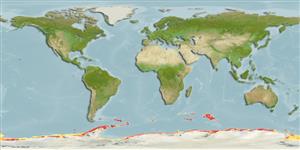Teleostei (teleosts) >
Perciformes/Notothenioidei (Icefishes) >
Nototheniidae (Cod icefishes) > Nototheniinae
Etymology: Lepidonotothen: Greek, lepis = scale + Greek, noton = back + Greek, adverbial particle, then, that denotes distance or remova (Ref. 45335).
More on author: Günther.
Environment: milieu / climate zone / depth range / distribution range
Ecology
Marine; benthopelagic; depth range 10 - 900 m (Ref. 11892), usually 195 - 312 m (Ref. 11892). Temperate; 45°S - 79°S, 180°W - 180°E (Ref. 5179)
Southern Ocean: South Georgia Island and Bouvet Island. Also known from sub-Antarctic islands and Antarctic Indian and Pacific Oceans.
Length at first maturity / Size / Weight / Age
Maturity: Lm 27.3, range 19 - 36 cm
Max length : 55.0 cm TL male/unsexed; (Ref. 5179); common length : 35.0 cm TL male/unsexed; (Ref. 2121); max. reported age: 19 years (Ref. 5789)
Feeds chiefly on macrozooplankton (mainly crustaceans, cnidarians and salps) and midwater fishes.
Dewitt, H.H., P.C. Heemstra and O. Gon, 1990. Nototheniidae. p. 279-331. In O. Gon and P.C. Heemstra (eds.) Fishes of the Southern Ocean. J.L.B. Smith Institute of Ichthyology, Grahamstown, South Africa. (Ref. 5179)
IUCN Red List Status (Ref. 130435: Version 2024-1)
Threat to humans
Harmless
Human uses
Fisheries: minor commercial
Tools
Special reports
Download XML
Internet sources
Estimates based on models
Preferred temperature (Ref.
123201): 1.3 - 2.8, mean 1.7 °C (based on 21 cells).
Phylogenetic diversity index (Ref.
82804): PD
50 = 1.0000 [Uniqueness, from 0.5 = low to 2.0 = high].
Bayesian length-weight: a=0.00468 (0.00395 - 0.00554), b=3.24 (3.19 - 3.29), in cm total length, based on LWR estimates for this species (Ref.
93245).
Trophic level (Ref.
69278): 3.5 ±0.52 se; based on food items.
Resilience (Ref.
120179): Low, minimum population doubling time 4.5 - 14 years (K=0.08-0.12; tm=7-9; tmax=19; Fec = >10,000).
Fishing Vulnerability (Ref.
59153): High to very high vulnerability (67 of 100).
Climate Vulnerability (Ref.
125649): High vulnerability (55 of 100).
Nutrients (Ref.
124155): Calcium = 18.9 [11.9, 33.9] mg/100g; Iron = 0.274 [0.173, 0.456] mg/100g; Protein = 15.9 [13.4, 18.6] %; Omega3 = 0.661 [0.365, 1.167] g/100g; Selenium = 22.1 [11.0, 43.5] μg/100g; VitaminA = 32.9 [10.7, 107.3] μg/100g; Zinc = 0.549 [0.402, 0.742] mg/100g (wet weight); based on
nutrient studies.
